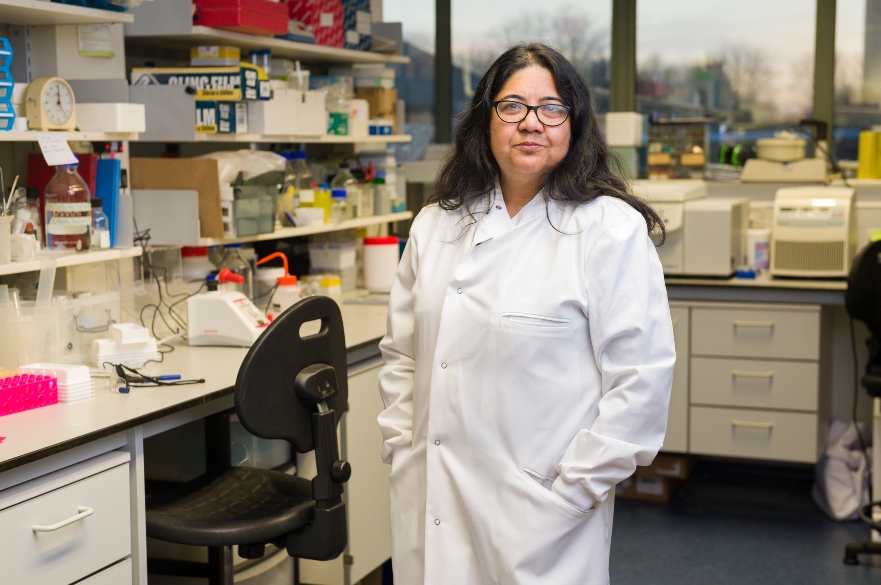Role
Dr Shreyasi Chatterjee is a Lecturer in the Department of Biosciences at NTU. Dr. Chatterjee’s laboratory primarily focuses on the molecular mechanisms that lead to Alzheimer’s Disease and investigates the early risk factors for this disease. Dr. Chatterjee’s laboratory is also interested in investigating the role of gut-microbiota in healthy ageing and the connection between gut-brain axis in neurodegenerative disorders.
Dr. Chatterjee is a supervisor for PhD, MRES, MSc and Undergraduate research projects. Dr. Chatterjee is also the module leader for Global Challenges of Health (BIOL34013) and currently lectures on Biomolecular Structure and Functions (BIOL22081), Living Systems (BIOL14406), Introduction to Biochemistry (BIOL14404), Molecular Genetics of human diseases (BIOL25013), Developmental and Evolutionary Genetics (BIOL34016).
Career overview
Dr. Chatterjee completed her PhD from Bose Institute, Kolkata, India and her Post-Doctoral research from University of California at Los Angeles and University of Texas Medical Branch at Galveston. During her Post-Doctoral research Dr. Chatterjee developed Drosophila models of neurodegenerative diseases namely Alzheimer’s Disease and Amyotrophic Lateral Sclerosis. These transgenic models were particularly useful for detecting candidate genes and deciphering the underlying molecular pathways leading to pathological conditions. In 2017, Dr. Chatterjee secured the Marie-Curie fellowship and joined University of Southampton as a Marie-Curie Research Fellow. Her research focused on investigating insulin-resistance in Type 2 Diabetes as a risk factor for Tauopathy in sporadic Alzheimer’s Disease in cellular and Drosophila models. She joined NTU as a lecturer in the Department of Biochemistry in the School of Science and Technology in 2020 continuing her research in neurodegenerative diseases.
Research areas
Research Areas
Research in the Chatterjee laboratory focuses on the following areas
Type 2 Diabetes as a risk factor of AD
Epidemiological studies have shown that people with Type 2 Diabetes have 1.5 to 2-fold increased risk of dementia including Alzheimer’s Disease (AD). One of the neuropathological hallmarks of Alzheimer’s Disease is the formation of neurofibrillary tangles (NFTs) in the brains of people with this disease. The main components of NFTs are hyperphosphorylated and aggregated forms of Tau protein. During my Post-Doctoral tenure at UCLA, I generated a Drosophila model of human Tau overexpression that was instrumental for conducting unbiased genetic screens to identify candidate genes that had the potential to modify Tau-induced phenotypes. Following on from this study, we identified several genes in the insulin signalling pathway as risk factors that can lead to abnormal Tau modifications which form the NFTs in the AD brains. Our data has shown that insulin resistance not only exacerbates the formation of hyperphosphorylated Tau protein but it also impairs autophagy leading to the accumulation of pathological Tau aggregates (Chatterjee et al. 2019. Frontiers in Neuroscience). One of the projects of my laboratory (in collaboration with Professor Amritpal Mudher, University of Southampton) is to investigate whether insulin-sensitising and autophagy-inducing drugs are able to ameliorate Tau pathology in cellular and Drosophila models of Tauopathy. Our laboratory is also looking at the impact of high-fat and high-glucose diet in these Drosophila models.
Another ongoing project in my laboratory with Dr. Amanda Coutts is to investigate the atypical roles of nuclear Tau protein in its interaction with the tumour suppressor p53.
The role of gut-microbiota in the pathogenesis of Alzheimer’s Disease
In collaboration with Professor Lesley Hoyle another project in my laboratory is to investigate the role of gut-microbiota dysbiosis in the pathogenesis of Alzheimer’s Disease. The aim of this project is to study the age-related alterations of gut microbiome in the wild-type vs the human Tau overexpressing Drosophila models.
TDP-43 in Alzheimer’s Disease
Cytoplasmic inclusions of Transactive Response DNA Binding Protein (TDP-43) are a characteristic feature of Frontotemporal Dementia (FTD) and Amyotrophic Lateral Sclerosis (ALS). Recent literature shows that TDP-43 aggregates are present in 57% of Alzheimer’s Disease cases and these are associated with the Neurofibrillary tangles of Tau protein. Using a Drosophila codon-optimized human TDP-43 (Choksi et al. 2014. Human Molecular Genetics) my laboratory is focused on studying the genetic interactions between the TDP-43 and Tau transgenics and the underlying molecular mechanisms that lead to the exacerbation of Tau pathology by TDP-43 aggregates. In parallel, we are also interested in studying these protein-protein interactions in vitro using neuroblastoma cell lines and induced pluripotent stem cells.
External activity
Reviewer
Reviewer of The Journal of Neurochemistry
Reviewer of The Neurochemical Research
Professional Membership
Alzheimer’s Research UK Midlands Network
Alzheimer’s Association
Diabetes UK
Biochemical Society
Collaborators
Professor Amritpal Mudher (University of Southampton)
Professor Delphine Boche (University of Southampton)
Dr. Anto Rajkumar Rajamani (University of Nottingham)
Grant Funding
2023 Jan – 2024 Jan: Alzheimer’s Research UK Pump priming Grant
Role: PI
Amount: £5,000
Agency: Alzheimer’s Research UK
2022 June – 2024 July: Strategic Health and Wellbeing Fund
Role: PI
Amount: £13,000
Agency: Nottingham Trent University
2016 Nov – 2018 Dec: Marie Slowdoska Curie Individual Fellowship
Role: Marie Curie Fellow
Amount: £150,000
Agency: European Union, Horizon 2020
2017 Oct – 2018 Dec: Wessex Medical Research Innovation Grant
Role: Research Fellow
Amount: £13,000
Agency: Wessex Innovation Grant
Sponsors and collaborators
Alzheimer’s Research UK Midlands Network
Diabetes UK
Publications
- Chatterjee S., Sealey M., Duque, M.,....Mudher, A:Age-related changes in Tau and Autophagy in human brain in the absence of neurodegeneration (in Press PLoS One 2023).
- Siney E., Prasannan P., Chatterjee S., Kurbatskaya K., Vargas-Caballero M., Mudher A. and Willaime-Morawek, S: A 3D-induced pluripotent stem cell-derived human neural culture model to study certain molecular and biochemical aspects of Alzheimer’s disease. In vitro models, 2022 October (1) : 447–462
- Yusuff T., Chatterjee S., Chang Y.C., Sang T.K., Jackson G.R: Codon-optimized TDP-43-mediated neurodegeneration in a Drosophila model for ALS/FTLD. (In Press Frontiers in Genetics).
- Chatterjee S., Ambegaokar S., Jackson G.R and Mudher A: Insulin-mediated changes in tau hyperphosphorylation and autophagic impairment induced by GSK-3 and ERK in cellular and Drosophila models of tau toxicity. Frontiers in Neuroscience, 2019 August (13):1-16.
- Chatterjee S. and Mudher A: Alzheimer’s Disease and Type 2 Diabetes: A critical assessment of the shared pathological traits. Frontiers in Neuroscience, 2018 June (12): 1-23.
- Siney EJ., Kurbatskaya K., Chatterjee S., Prasannan P., Mudher A. and Willaime-Morawek S: Modelling neurodegenerative diseases in vitro: Recent advances in 3D iPSC technologies. AIMS Cell and Tissue Engineering, 2018 March 2(1):1–23.
- Chouhan AK, Guo C, Hsieh YC, Ye H, Senturk M, Zuo Z, Li Y, Chatterjee S, Botas J, Jackson GR, Bellen HJ. and Shulman JM: Uncoupling neuronal death and dysfunction in Drosophila models of neurodegenerative disease. Acta Neuropathol Commun. 2016 Jun 23; 4(1):62.
- Choksi D., Roy B., Chatterjee S., Yusuff T., Bakhoum B., Sengupta U., Ambegaokar S., Kayed R. and Jackson G.R: TDP-43 phosphorylation by Casein Kinase I promotes oligomerization and enhances toxicity in vivo. Human Molecular Genetics, 2013 Nov 18: 1-11. (Impact factor 7.6). (*Second author in the above publication)
- Chatterjee S., Sang T.K and Jackson G.R: Dissociation of Tau Toxicity and Phosphorylation: role of GSK-3β, MARK and Cdk5 in a Drosophila Model. Human Molecular Genetics, 2009 Jan1:18:164-177. (Impact factor 7.6, Citations 72).
- Stanislav LL.,Sang T.K.,Gehman LT., Chatterjee S., Liu J.,Lawless GM.,Sengupta S., Berry RW., Geshwind DH. and Jackson G.R: A genomic screen for modifiers of tauopathy identifies puromycin sensitive aminopeptidase as an Inhibitor of tau-induced neurodegeneration. Neuron, 2006 September 7: 51 (5). (Impact factor 16, Citations 78).
- Chatterjee S., Mitra M., and Dasgupta S.K: A high yielding mutant of mycobacteriophage L1 and its application as a diagnostic tool. FEMS Microbiology Letters, 2000 July 188: 47-53. (Impact factor 2.0, Citations 24).

